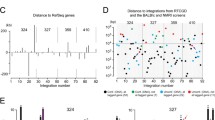Abstract.
When a retrovirus infects a cell, its RNA genome is reverse transcribed into a double-stranded DNA, which is then permanently integrated into the host chromosome. Integration is one of the essential steps in the retroviral life cycle. Many transposable elements also move around and integrate into the host genome as part of their life cycle, some through RNA intermediates and some through ‘cut-and-paste’ mechanisms. Integration of retroviruses and transposable elements into ‘sensitive areas’ of the genome can cause irreparable damage. On the other hand, because of their ability to integrate permanently, and the relatively efficient rates of transgenesis, retroviruses and transposable elements are widely used as gene delivery tools in basic research and gene therapy trials. Recent events in gene therapy treatments for X-linked severe combined immunity deficiencies (X-SCID) have highlighted both the promise and some of the risks involved with utilizing retroviruses. Nine of 11 children were successfully treated for X-SCID using a retrovirus carrying the gene mutated in this disease. However, later two of these children developed leukemias because of retroviral integrations in the putative oncogene LMO2 [1]. A third child has also been demonstrated to have an integration in LMO2, but is as of yet nonsymptomatic [2]. It is a bit difficult to explain the high frequency of integrations into the same gene using a random model of retroviral integration, and there has been evidence for decades that retroviral integrations may not be random. But the data were somewhat limited in their power to determine the precise nature of the integration biases. The completion of the human genome sequence coupled with sensitive polymerase chain reaction techniques and an ever-decreasing cost of sequencing has given a powerful new tool to the study of integration site selection. In this review, we describe the findings from several recent global surveys of target site selection by retroviruses and transposable elements, and discuss the possible ramifications of these findings to both mechanisms of action and to the use of these elements as gene therapy vectors.
Similar content being viewed by others
Author information
Authors and Affiliations
Corresponding author
Additional information
Received 13 May 2004; received after revision 21 June 2004; accepted 6 July 2004
Rights and permissions
About this article
Cite this article
Wu, X., Burgess, S.M. Integration target site selection for retroviruses and transposable elements. CMLS, Cell. Mol. Life Sci. 61, 2588–2596 (2004). https://doi.org/10.1007/s00018-004-4206-9
Issue Date:
DOI: https://doi.org/10.1007/s00018-004-4206-9




